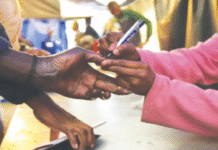Development is often used as a buzz word by politicians, leaders, philanthropists, businesses and multinational conglomerates to showcase achievement. If the international hegemony tries to insinuate it through setting up milestone targets such as Millennium Development Goals (MDG) and displaying progress through periodic reports, it remains a lynch-pin of politics and business in developing regions, where everyone grows up observing and accepting pervasive poverty, coexisting with it and using it.
The issue is intrinsically related to daily living in developing nations, where a vast working-age, young, hard-up population without jobs, education, health services or the prospect of getting them is also being used by the well-off as they see fit — as house maids, garment workers, farm hands and the like. Though this perhaps accentuates Darwin’s theory of the survival of the fittest, the privileged have a stake in it — and that may not always be to the advancement of the indigent.
We are frequently reminded that economic growth combats poverty, as the flow-on effect of wealth creation reaches the poor, raising them from their sorry state. For the most part this is true, but not always; other factors are present, particularly those determining whether growth is equally distributed. This is observed throughout the history of mankind, and our region poses a contemporary parallel.
India, for example, has enjoyed solid growth, along with its much-praised fair elections, free press, rule of law, tolerant plural democracy or secular approach. It has produced world-ranking billionaires, academics, scientists, businesses, policymakers, think-tanks and activists. Yet, despite lauded and consistent economic growth, it continues to fail many of its poor citizens – in providing basic health, education or living conditions. Why?
 Amartya Sen, awarded the Nobel prize for his work on welfare/development economics and social choice theory and for his eagerness in studying the problems of society’s poorest members, has recently written another book (with Professor Jean Drèze) on the issue of inequality, An Uncertain Glory: India and its contradiction. Professor Sen argues that deeply entrenched inequality in Indian society, a long harboured attitude of ’ruling and neglecting’ among the elite results in stark imparity among India’s vastly diverse people. The imparity is obvious to untrained eyes, flashing before them in issues of caste, gender, education and above all income. Ironically the group that is working to change this — newspaper editors, readers, opinion writers, activists, NGOs, owners or chief executives and academics — is largely from a privileged background.
Amartya Sen, awarded the Nobel prize for his work on welfare/development economics and social choice theory and for his eagerness in studying the problems of society’s poorest members, has recently written another book (with Professor Jean Drèze) on the issue of inequality, An Uncertain Glory: India and its contradiction. Professor Sen argues that deeply entrenched inequality in Indian society, a long harboured attitude of ’ruling and neglecting’ among the elite results in stark imparity among India’s vastly diverse people. The imparity is obvious to untrained eyes, flashing before them in issues of caste, gender, education and above all income. Ironically the group that is working to change this — newspaper editors, readers, opinion writers, activists, NGOs, owners or chief executives and academics — is largely from a privileged background.
Our region and India are not alone in displaying inequality. In various degrees this can be shown in Brazil, China or Russia, other nations with recent strong economic growth. Inequality is also found in wealthy developed countries. Australia, despite its decades-long strong growth and improved average income, continues to leave parts of the community behind. Significant numbers of Americans are still poor and neglected while its GDP has risen and it has been the world’s largest economy for nearly a century.
So, when it was announced in June that Bangladesh has made remarkable progress in reducing poverty, is on track to meet the eight MDGs – in particular, the first MDG to eradicate extreme poverty – ahead of target year 2015, I was mildly encouraged. Even though our achievement is praised, highlighted and promoted by politicians at home and away, as a mega-success, there is a danger of overlooking a profound ‘opportunity cost’. This microeconomic term describes the value that one forgoes to attain something else, when a choice is made between mutually exclusive alternatives.
As we achieve our aspirational targets we are depriving generations of opportunities to learn. Indeed, the crux of the ‘opportunity cost’ theory is that if the best choice is made (for example, if young people choose to study instead of working and earning), in the long run opportunity cost can be overcome.

Photo: Reuters
Are we making the best choice? Do poor people even have opportunities to pick the best option? In the absence of recognised safety-nets — the poor can beg for work — poor families trade education in order to earn a livelihood; whatever the quality of state education, especially in rural areas, attending school instead of working for food is seldom an option. NGOs, microcredit, social business entrepreneurs and philanthropic organisations help many to survive and to get a chance to go to school, but many still miss out.
As the same a World Bank report suggested “particular emphasis needs to be placed on programs that focus on early childhood development in ways that integrate health and nutrition services, pre-school education, early stimulation and learning; also on programs focused on building skills and improving the employability of poor youth“.
Culture and tradition are just as much to blame for persistent poverty as other already well-campaigned issues such as corruption, governance and greed. The Asian Development Bank has recently analysed, in a report, social protection programs in 35 countries in Asia and the Pacific in order to build a Social Protection Index. The report has found that South Asia stands out with poor social protection programs – with relatively low depth (the average benefits received by actual beneficiaries) and breadth (the proportion of intended beneficiaries who receive benefits). With assistance reaching out only partially to the intended beneficiaries, governments find it easier to run ‘work for food’ schemes or to give out subsidised grains.
Even in the prosperous South-East, social protection although widespread is thin, with the idea of a welfare state still in an embryonic state. The region prefers to rely on youth, growth, family and other supports.
Then, for democracy and freedom, still evolving and anything but great at present, our region has forgone rapid development. The sub-continent has had democratic and human rights pioneers; India, in particular, is often admired for its democratic processes, institutions, plurality or a perceived equal to all citizen attitude. But if you compare the economic development of India with China, or that of Bangladesh with Vietnam (in the last 20 years alone), a different story could be told – a tale of strong and disciplined albeit somewhat autocratic leadership vis-à-vis missed opportunity.
We would not want to champion the violation of human rights or autocracy; but democracy, with efforts to establish democratic processes taking several more turns of evolution and decades of developing its own cause before becoming established, is putting our society under severe stress.
For example, democratic, once socialistic, economically growing and politically very important India, in spite of a woeful public health record, spends on average a miserly $39 per person per year for public health, compared with China’s $203 or Brazil’s $483. India’s total amounts to 1.2% of GDP, against a global average of 6.5%, as rich and poor Indians pay doctors and quacks. But even good private providers do nothing for preventive care and better health education (The Economist, 29 June 2013).
We are doing better than before and lifting more people out of poverty. Everyone has contributed to Bangladesh’s MDG achievement: successive governments of both persuasions, a large contingent of expatriate labourers sending billions back home, visionary NGOs with innovative and determined efforts, private philanthropists and local entrepreneurs including the much-maligned readymade garment industrialists who exploit but employ a significant number of the destitute. Indeed, the World Bank and the analysts are correct in stating that with political stability and improved governance, the country could achieve more growth with the same level of investments.
But a serious rethink, particularly to involve the prosperous, is necessary. With the low base from which we have started lacking established independent institutions, productive democratic practice and economic certainty as we amble through a growth phase, solving the poverty issue needs, on the one hand, policy initiatives from governments and efforts by entrepreneurs from for and not-for-profit organisations, and on the other an improved public understanding.
The famines of colonial years may have disappeared but the severity of human deprivation in our region has not, and it should not be overshadowed by unbridled optimism or broad conclusions.
We cannot promote growth without worrying about equity. The term ‘inclusive growth’ is doing the rounds in the developed world, where the gap between the rich and the poor has been widening in recent time, primarily because incomes for the top earners are increasing faster than others.
As is there, and regardless our remarkable success in meeting MDG targets, a renewed focus is needed so that our growth also touches the poor.
——————————-
Irfan Chowdhury writes from Canberra, Australia.
Source: bdnews24










